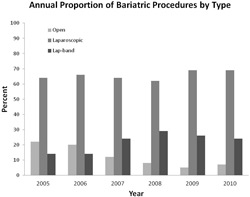|
Back to 2014 Annual Meeting Posters
Blood Transfusion Among Patients Undergoing Elective Bariatric Surgery for Weight Reduction: a Nationwide Perspective
Toms Augustin*2, Kimberley E. Steele1, Stacy a. Brethauer2, Joseph K. Canner1, Eric B. Schneider1
1Surgery, Johns Hopkins University School of Medicine, Baltimore, MD; 2Surgery, Cleveland Clinic, Cleveland, OH
Background:
Significant perioperative blood loss and transfusion are thought to occur infrequently among patients undergoing bariatric surgery. Little has been reported regarding bariatric procedure types and blood product utilization. We compared non-autologous transfusion across procedure type among patients undergoing open and laparoscopic Roux-en-Y procedures and laparoscopic gastric banding (lap-band).
Methods:
Data from the HCUP Nationwide Inpatient Sample from 2005 through 2010 were examined and all electively admitted patients with a diagnosis of morbid obesity who underwent open (ICD-9-CM 44.31 & 44.39), or laparoscopic (ICD-9-CM 44.38) Roux-en-Y bypass or lap-band (ICD-9-CM 44.95) were identified. After excluding patients with abdominal cancer (ICD-9-CM 150.0-159.9, 230.1-230.9), proportional non-autologous blood-product transfusion (ICD-9-CM 99.03, 99.04) was compared across procedure types using Chi-square tests and multivariable logistic regression controlling for patient age, gender and year of procedure.
Results:
From 2005-2010, approximately 569,754 patients (79.8% female; mean age 44.2 [SD 11.5] years) underwent open (12.1%) or laparoscopic (65.3%) Roux-en-Y bypass, or laparoscopic band (22.6%). Lap-band patients were slightly older (mean age 45.8 years vs. 43.7 for open and 43.7 for laparoscopic patients respectively [p<0.001]) and less likely to be female (77.8% vs. 79.5% open and 80.5% laparoscopic respectively [p<0.001]). The proportion of patients undergoing open procedures dropped from 21.9% in 2005 to 6.9% in 2010 (see Figure). Overall, a total of 1.7% received non-autologous blood products (3.0% open vs. 1.9% laparoscopic vs. 0.3% lap-band respectively [p<0.001]). Compared with patients undergoing laparoscopic procedures, those treated with open procedures demonstrated greater odds of transfusion (OR 1.56; 95% CI 1.39-1.75) while those undergoing lap-band procedures had substantially reduced odds of transfusion (OR 0.13 ; 95% CI 0.10-0.16). There was no change in the proportion of open-procedure patients undergoing transfusion across the study period (range: 2.64%-4.02%, p=1.71). However, overall, blood transfusion decreased, in parallel with the declining number of open procedures, from a high of 1.89% in 2005 to a nadir of 1.36% in 2008 (p<0.001).
Conculsion:
Among bariatric surgery patients, non-autologous transfusion was relatively uncommon; however, compared with patients treated laparoscopically, patients undergoing open procedures were 56% more likely to undergo transfusion, while those undergoing lap-band procedures 87% less likely to undergo transfusion. Continuing the trend away from open Roux-en-Y bypass may further reduce the potential need for perioperative blood products in bariatric surgery patients.

Back to 2014 Annual Meeting Posters
|


